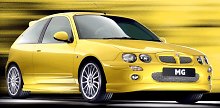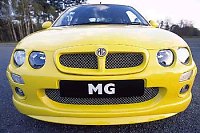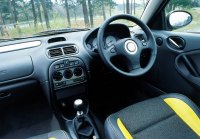 Revamping
the Rover 200 and renaming it to 25 is part of a program trying to stop
sales decline. If you remember, the 200 was the first new Rover after
the
Honda era, but it was not gifted with a proper suspension and steering
tuning. In terms of market positioning, obviously Rover gave it a wrong
target : the larger D-segment headed by VW Golf. Now, the BMW
management
eventually realised that the "prestige" image would never work. They
repositioned
the Rover 25 against the likes of Fiat Punto, Ford Fiesta, VW Polo,
Peugeot
106, Renault Clio etc., launched a dramatic price cut to stop bleeding. Revamping
the Rover 200 and renaming it to 25 is part of a program trying to stop
sales decline. If you remember, the 200 was the first new Rover after
the
Honda era, but it was not gifted with a proper suspension and steering
tuning. In terms of market positioning, obviously Rover gave it a wrong
target : the larger D-segment headed by VW Golf. Now, the BMW
management
eventually realised that the "prestige" image would never work. They
repositioned
the Rover 25 against the likes of Fiat Punto, Ford Fiesta, VW Polo,
Peugeot
106, Renault Clio etc., launched a dramatic price cut to stop bleeding.
For a mid-life revamp, the Rover 25 has done quite a lot, especially is to the aspects involving driving pleasure. Sportier spring / damping / anti-roll bar combination is out of a different damping theory. Not only improves body control, but the bump absorption is hugely improved. The 12% faster rack-and-pinion steering also quicken steering response and improves feel. Obviously, BMW is pushing Rover to be the front-wheel-drive version of "Ultimate driving machine". Ultimately, it might not be as exciting to handle as Ford Fiesta, but it is no longer afraid of the best of the rest. At the engine compartment, a lower tuned version of the 1.4-litre (at 83hp) and the MGF’s 118hp 1.8-litre have been added. The 118hp unit could be mated with a CVT with 6 artificial sequential manual ratios as already applied to MGF Steptronic. Next year will come a 1.1-litre 16V (est. 70hp). The top of the range remains to be the 1.8 VVC unit with 145hp. In terms of engine, Rover’s K-series won’t let you down, no matter in terms of power or eagerness. However, in terms of packaging, there is a mixed feeling in this car. Inside, the aging plastic dashboard is unchanged, just new seats and new door trimming add a little bit freshness. Outside, the revised nose incorporating 4 circular headlights (a new company resemblance feature) plus the new grille and bumper raised the styling to new height. That
is not enough to make the 25 a class winner. Its packaging is still out
of the school of the 80s. Excessive overhangs at front and rear result
in an inefficient use of space. This mean the car carry 100kg more than
its rivals with comparable interior space. |
| The above report was last updated on 29 Nov 99. All Rights Reserved. |
 During
the transition period from Rover to MG, the struggling British car
maker
will produce a line of MG cars alongside their Rover roots. Take this
MG
ZR as example, it is the MG version of Rover 25, with hotter look and
tuning
but it will offer a full range of engines from the warm 105hp 1.4 to
the
high-performance 160hp 1.8 VVC. In other words, the ZR will eventually
replace the whole 25 lineup.
During
the transition period from Rover to MG, the struggling British car
maker
will produce a line of MG cars alongside their Rover roots. Take this
MG
ZR as example, it is the MG version of Rover 25, with hotter look and
tuning
but it will offer a full range of engines from the warm 105hp 1.4 to
the
high-performance 160hp 1.8 VVC. In other words, the ZR will eventually
replace the whole 25 lineup.
 Given
a weak basis of Rover 25, I don’t have much expectation from this
ZR160.
Basically, this car is derived from the old 25 GTi with the VVC engine
pumped up to deliver 160 horsepower in a peaky manner while the 128
lbft
of torque is simply untouched. If you remember this engine is already
serving
the limited edition MGF Trophy 160, you don’t need to be told that the
power hike is the result of improved breathing and remapped ECU. The
latter
also improves throttle response, but the engine never feel as powerful
as Volkswagen’s 1.8T (even the 150hp version) and the French’s
2.0-litre
opponents. You need to work hard on rev with the close-ratio gearbox to
extract the extra performance, which is not much. It is also very noisy.
Given
a weak basis of Rover 25, I don’t have much expectation from this
ZR160.
Basically, this car is derived from the old 25 GTi with the VVC engine
pumped up to deliver 160 horsepower in a peaky manner while the 128
lbft
of torque is simply untouched. If you remember this engine is already
serving
the limited edition MGF Trophy 160, you don’t need to be told that the
power hike is the result of improved breathing and remapped ECU. The
latter
also improves throttle response, but the engine never feel as powerful
as Volkswagen’s 1.8T (even the 150hp version) and the French’s
2.0-litre
opponents. You need to work hard on rev with the close-ratio gearbox to
extract the extra performance, which is not much. It is also very noisy.
 Comparatively,
suspension tuning seems mild. If the 25 were a modern hatchback, it
won’t
need a magic to be converted to a real hot hatch. However, it was
launched
back in late 1995 (in the name of Rover 200) thus body stiffness is not
comparable to today’s hatches. Without applying any reinforcing, MG
Rover
struggled to achieve the right balance between sportiness and ride
comfort.
The result is a compromise thus satisfy neither sides. Drive it at
eight-tenths
effort, the stiffened suspension, hardened bushing and lowered ride
height
do deliver spirited handling. It is chuckable, throttle steerable and
it
corners flat, with good grip from 205 width 17-inch tyres and
reassuring
stopping power from larger brake discs. However, push it to limit and
its
shortcomings are revealed - excessive body roll, loss of grip and
instability.
On the other hand, ride quality is also inferior to most rivals. On
broken
surfaces it fails to overcome bumps that the French rivals can do
easily,
discomforting the occupants and reducing grip.
Comparatively,
suspension tuning seems mild. If the 25 were a modern hatchback, it
won’t
need a magic to be converted to a real hot hatch. However, it was
launched
back in late 1995 (in the name of Rover 200) thus body stiffness is not
comparable to today’s hatches. Without applying any reinforcing, MG
Rover
struggled to achieve the right balance between sportiness and ride
comfort.
The result is a compromise thus satisfy neither sides. Drive it at
eight-tenths
effort, the stiffened suspension, hardened bushing and lowered ride
height
do deliver spirited handling. It is chuckable, throttle steerable and
it
corners flat, with good grip from 205 width 17-inch tyres and
reassuring
stopping power from larger brake discs. However, push it to limit and
its
shortcomings are revealed - excessive body roll, loss of grip and
instability.
On the other hand, ride quality is also inferior to most rivals. On
broken
surfaces it fails to overcome bumps that the French rivals can do
easily,
discomforting the occupants and reducing grip.